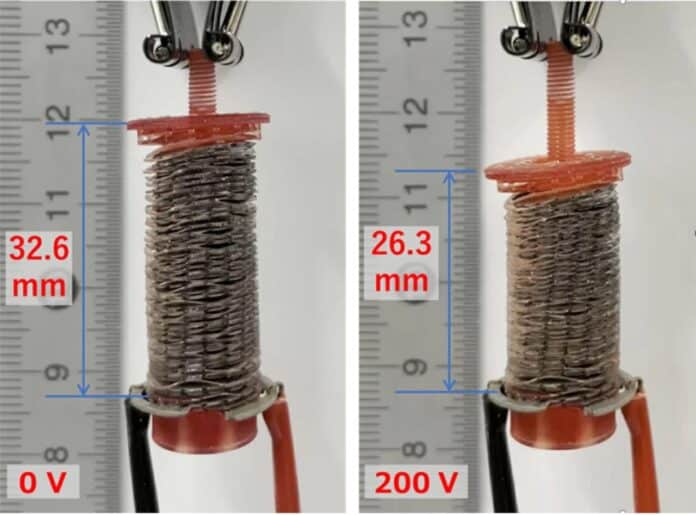Devices called electrostatic actuators move objects by using electric fields. These devices are made up of two electrodes with opposing charges that produce a force whenever an electric field forms between them. Different configurations of electrostatic actuators have been devised where the force can resemble that of contracting muscles by changing the form of their electrodes and filling the space between them with flexible, pliable materials.
However, it may be possible to use electrostatic actuators in artificial muscles thanks to research from the Tokyo Institute of Technology (Tokyo Tech) that used ferroelectric materials to create an electrostatic actuator that can generate a strong force at a low driving voltage.
Scientists increased the accumulated charge to increase the force generated by actuators. They did this by utilizing ferroelectric materials that spontaneously polarize.
Charge separation (polarization) occurs when an electric field is applied to ferroelectric materials. In contrast to normal paraelectric materials, Ferroelectrics maintain their polarisation long after the electric field is removed, enabling them to sustain many accumulated charges at a low voltage. The resultant force is also linearly proportional to the applied voltage since the polarisation of ferroelectric materials is independent of voltage.
Professor Suzushi Nishimura said, “Ferroelectric media are superior to ordinary paraelectric media for electrostatic actuators in two respects. One is that they can generate a higher force by maintaining a large polarization even at low voltage. The other is that their voltage response is almost linear, resulting in good device controllability.”
Scientists then used liquid crystals in the special nematic phase as a ferroelectric material. The material was found to flow like a liquid at room temperature while possessing a rod-shaped molecular structure like that of solid crystals–necessary characteristics that give these materials a significant dipole moment and the fluidity required for their use in artificial muscles.
In experiments, it was discovered that ferroelectric liquid crystals produced forces across electrodes 1,200 times greater than those produced by traditional paraelectric materials such as insulating oils. The scientists have created an electrostatic actuator that can contract and expand like muscles at low voltages using ferroelectric liquid crystals and a 3D-printed double-helical coil electrode.
Prof. Nishimura said, “When we applied an electric field of 0.25 MV m-1, the device contracted by 6.3 mm, which is about 19% of its original length. Visual observation showed that the device moves when a voltage of 20 V is applied. Even a dry cell battery can power the present actuator.”
These findings demonstrate that ferroelectric materials with spontaneous polarization are promising for developing electrostatic actuators suitable for artificial muscles.
Journal Reference:
- Suzushi Nishimura et al. Lowering Electrostatic Actuator Driving Voltage and Increasing Generated Force Using Spontaneous Polarization of Ferroelectric Nematic Liquid Crystals. Advanced Physics Research. DOI: 10.1002/apxr.202200017
